Last Updated on April 24, 2023
Courageous, dignified, and high-spirited, the Irish Terrier, also known as the Daredevil, actually has an upbeat personality and soft heart.
They may share their bloodline with the Irish Wolfhound, but they got an appearance and temperament that makes them unique.
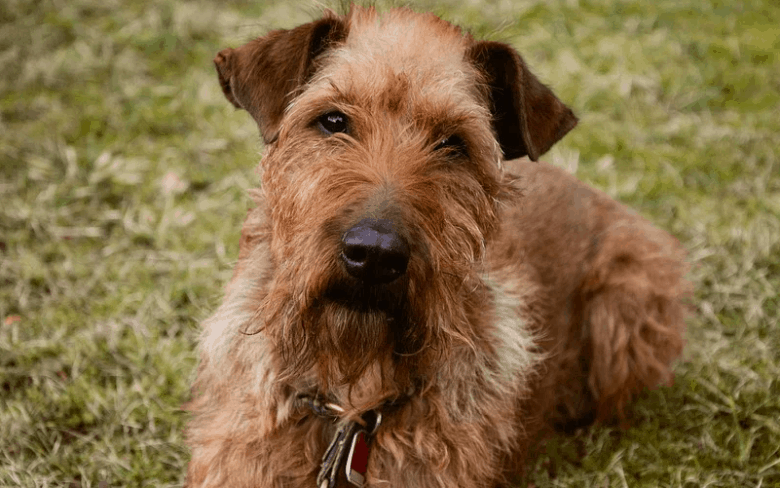
If you’re wondering if the Irish Terrier is the faithful canine companion you’re looking for, stay with us while we uncover more about this pooch.
Quick Navigation
- 1 Where did the Irish Terrier originate?
- 2 What does an Irish Terrier look like?
- 3 Temperament: Are Irish Terriers good family dogs?
- 4 How to take care of your Irish Terrier
- 5 What health problems do Irish Terriers have?
- 6 How much is an Irish Terrier?
- 7 Curious about Irish Terrier Mixes?
- 8 Who should get an Irish Terrier?
- 9 Further reading: Terrier Breeds
Where did the Irish Terrier originate?
Bred as an all-purpose farm dog, Irish Terriers came from Ireland’s Emerald Isle where they became the ultimate farmer’s friend.
They weren’t just guarding flocks or livestock, but they also became hunting companions and watchdogs.
It’s no wonder that versatile canines like these had had a big role in history, like serving as messengers during World War I.
They became one of the most popular breeds because of their high aptitude for various tasks that they were tagged “gentleman’s favorite” and “poor man’s sentinel.”
Being one of the rare and oldest Terrier breeds, their fanciers started developing them around the 1870s.
Eventually, they got recognized by the American Kennel Club (AKC) in 1885 under the Terrier Group.
What does an Irish Terrier look like?
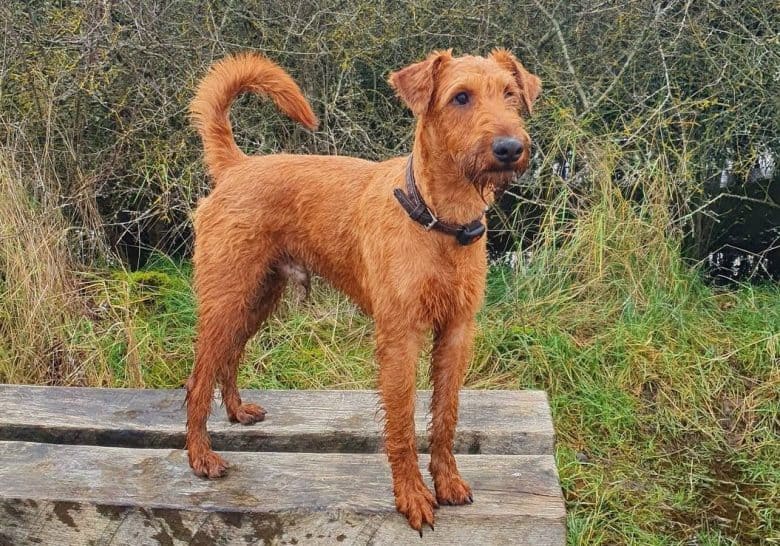
According to their AKC breed standard, the Irish Terrier dog breed has a conformation that shows a balance of harmony, proportion, and symmetry.
They convey a character and gait that’s sturdy and strong-boned with an agile and graceful gait. Their structure has no room for clumsiness, only for endurance, power, and seed.
Its goatee adds up to its gentlemanly-appearance. This purebred’s long head has a flat-looking skull that gets quite slim on the snout that has a bony yet muscular jaw.
Small, dark brown, and beady eyes make it seem like they’re stuffed toys with floppy V-shaped ears that perk up sometimes. But their gaze has an intense expression indicating their intelligence.
The tail, or stern, is docked while they’re pups, getting rid of a quarter of the original length.
Irish Terrier size: How big does an Irish Terrier dog get?
This dashing doggo has a height of 18 inches (45 cm) and a weight of 25 to 27 pounds (11 to 12 kg). And the size difference between males and females aren’t that obvious, unlike with other breeds.
An Irish Terrier puppy will reach these full-grown measurements once they’re 14 months old.
Keep in mind, though, that not all small- to medium-sized canines are suitable for apartment-living.
You always have to consider a specific breed’s energy level so you’ll know which type of home they’ll thrive in.
For Irish Terriers, they can adjust to small homes, but a house with at least a small backyard is more recommended.
In case you see someone offering a Miniature Irish Terrier, it’s probably NOT a purebred.
Unless you’re interested in Irish Terrier mixes, then you just have to check the credentials of the breeder and health certificates of the pup to push through on getting that mini terrier.
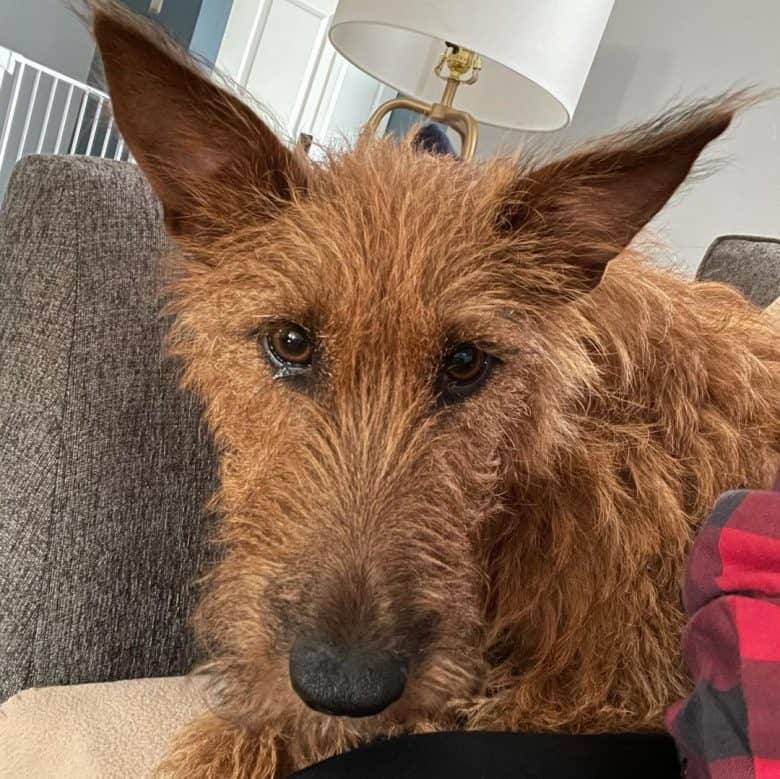
The Irish Terrier’s wiry coat
This doggo has a short and wiry double coat made of a dense undercoat that’s fine and soft, which helps regulate its body temperature, while its stiff outer coat is weather- and dirt-resistant.
We can mostly see Irish Terriers sport a coat color in different shades of red, hence the name Irish Red Terriers. It can be a golden-red coat, bright-colored, wheaten, or one that looks like a fawn or a pale yellow.
The first Irish Terriers appear in more colors that aren’t accepted by dog shows like brown or brindle. Others were able to see black and tan Terriers, too.
The only marking you’ll see on them is a small patch of white on their chest.
Irish Terrier puppies are sometimes born with dark-colored hair, but it lightens up and becomes red as they grow up.
Temperament: Are Irish Terriers good family dogs?
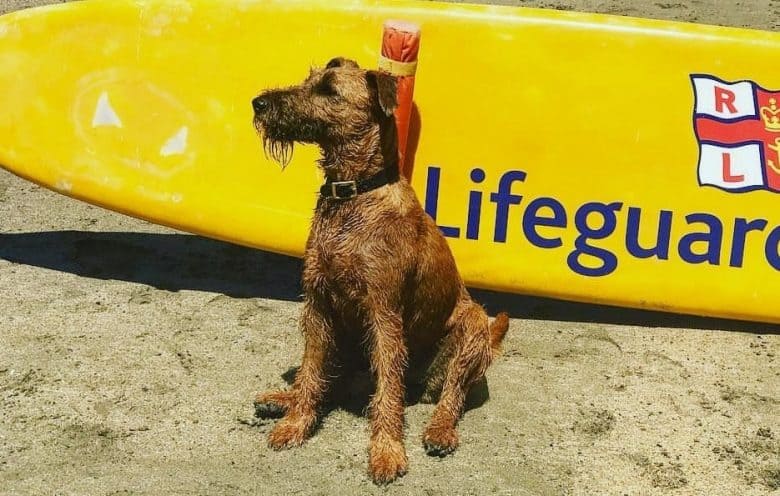
Kind-natured and affectionate, Irish Terriers are excellent family pets. They do well with everyone – kids, adults, and elderly people – as long as they’re given proper training and early socialization.
Not only are they patient and friendly, but they’re also outstanding guard dogs, thanks to their past!
Surprisingly, they don’t do well with other dogs of the same gender, even between siblings!
Not everyone knows this, but there’s a thing called same-sex aggression, which also applies to other dog breeds like Pitbulls and Akitas.
This doesn’t mean all canines are the same and can be judged because they’re the same breed.
Each of them has their own history, personality, and experiences that play a big role on how one pooch would react to any situation.
Irish Terriers are not aggressive in nature, but they are protective and territorial. If they feel threatened, they’ll bark and growl. If provoked and their owner is in danger, they’ll step up and attack – only if they have to.
When it comes to cats and other pets like birds and hamsters, terriers have similar backgrounds – hunting and killing vermin.
It’s safe to say that they have a strong prey drive and will do better as an only dog in a household.
Can Irish Terriers be left alone?
No, they don’t. They may tolerate 5 or 6 hours, but after that, expect your terrier to act up or develop separation anxiety.
If ever you need to be away longer, we suggest having a relative or friend come over, or you can hire a dog sitter.
They love attention and enjoy being surrounded by their humans.
If you want this doggo and you have a big, active family with outdoor space, then these are some of the things you can tick off your checklist.
With high energy levels, Irish Terriers like playing and jumping around, even swimming! Doing so shows how happy they are, but it also keeps them stimulated and healthy.
Just like these guys in the video enjoying beach day:
You’d also be glad to know that these terriers are highly intelligent and are easy to train.
Use your Irish Terrier’s eager-to-please trait to go learn some tricks, commands, and be more well-mannered. Your pup can start training as early as eight weeks old.
Stick to positive reinforcement, though, because this breed is sensitive and harsh treatment will make your fido timid.
How to take care of your Irish Terrier
Everyone thinks that caring for a dog is easy, but it’s actually challenging. Your dog isn’t just a pet that entertains you, but he’s a family member.
Acknowledging their needs and keeping them healthy is our job as an owner.
And just because Irish Terriers are adaptable to different weather conditions and have a functional coat, doesn’t mean you’re going to make him stay outside.
Your pup should live inside your home with you. But what else should you know about taking care of an Irish Terrier?
Exercising your Irish Terrier
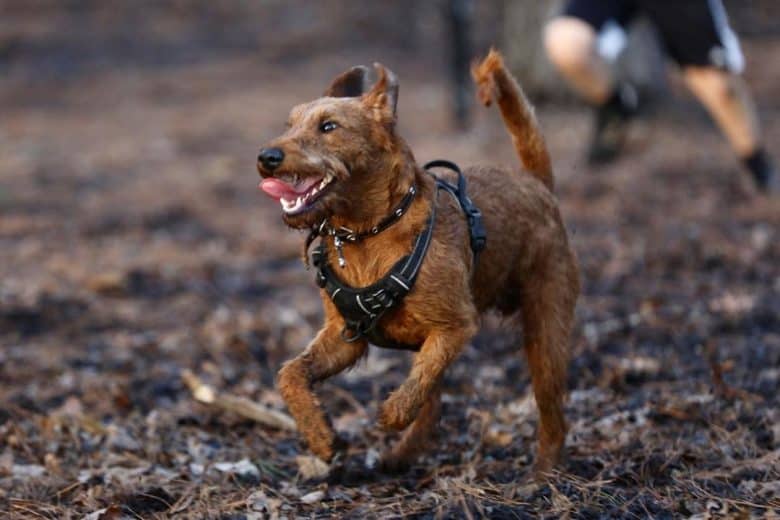
If you consider the Irish Terrier’s history as a working dog – responsible for much of daily life on the farm – it follows that these dogs have considerable exercise needs. These red Terriers should take long, brisk walks every day.
Irish Terriers are energetic by nature with high activity levels. It’s best to nurse what your dog has a natural affinity to, so stimulation and exercise are key to raising a happy, healthy Irish Terrier.
Irish Terrier Grooming: Do Irish Terrier dogs shed?
Since Irish Terriers barely shed, the clipping every 6 months is important. This will loosen the dead hair on the dog’s coat and keep him looking dapper and healthy.
The rest of the grooming regime is also quite simple – except for the clipping. Veterinarians recommend getting a professional groomer to undergo the clipping.
You won’t have to invest much time in the way of maintenance, as the Irish Terrier doesn’t require much.
Due to the repellant fur, you will only need to brush your Daredevil once or twice a week. This will make sure he doesn’t get smelly.
If you or someone in the family has sensitive skin, you don’t have to worry. Irish Terriers are hypoallergenic. This added benefit is a plus for family dogs when you consider the sensitivity of children’s skin.
As we mentioned, this breed is low maintenance. The brushing will do most of the work, and you’ll only need to bathe an Irish Terrier when he’s particularly foul or dirty.
This won’t happen much since the double coat repels most of the grease that causes a bad smell.
Bathing is a simple process of lathering some species-specific dog shampoo on your pet and rinsing with lukewarm water.
Irish Terrier Food Consumption
Fully grown Irish Terriers need to eat 1 – 1.5 cups of kibble per day or an equal amount of cooked meats and vegetables. You can even give them rice, apples, and bananas.
Irish Terrier puppies up to about twelve weeks will need four small portions throughout the day.
From 3-6 months, you can decrease to three portions per day, and taper off as the Irish Terrier reaches two or three years old when he needs to be fed only once a day.
You want to make sure you give your Irish Terrier high-quality dog food. Although they can eat just kibble, your Irish Terrier will love some of your ‘human foods’ as well.
Diced-up eggs, cooked chicken, and turkey are the best in terms of human food. You can also feed an Irish Terriers some cooked potatoes or buy lamb mince from your local pet store.
Make sure you read up on what foods dogs cannot eat so that you know what to blacklist when you’re giving your Irish Terrier a treat.
What health problems do Irish Terriers have?

Like any pure breed, the Irish Terrier possesses some hereditary diseases. The good news is you can prepare for whatever symptoms arise and figure out how to manage them.
Overall, the risk of severe health problems is low with this breed.
To raise a happy and healthy Irish Terrier, you’ll need to follow the feeding scheme we outlined above. Exercise is critical, too, to maintain your Daredevil’s metabolism.
Here are common health concerns identified in Irish Terriers:
- Hyperkeratosis in canines is a skin condition that produces an excess of keratin. This leads to the thickening of the skin in the nose and paw pads. The thick skin then hardens and cracks, causing secondary infections.
- Cystinuria is a hereditary disease that creates bladder and kidney stones. The kidneys are then unable to filter cystine out of the body properly. Cysturnia amongst Irish Terriers is common. Dogs become symptomatic at the age of 4 or 5.
- Degenerative Myelopathy (DM) is a terrible progressive disease of the spinal cord. Early symptoms of DM include decreased coordination, especially in the hindquarter legs. As the condition worsens, this paralysis gets worse as well.
- Hip and Elbow Dysplasia occurs when joints in the hip sockets or the elbows are misaligned or grow at uneven speeds. This can lead to a secondary disease called arthrosis. Watch out for early symptoms of limping or difficulty getting up.
- Urolithiasis (Urinary Stones) is caused by bacterial infection of the bladder and affects the lower urinary tract. The infection results in the crystal formation of different minerals. Early symptoms for urinary stones include blood in the urine or difficult urination.
- Cataracts occur when the lenses of the eyeball turn opaque, constructing the pathway of light to the retinae. This is a common affliction that leads to vision loss and eventual blindness.
- Progressive Retinal Atrophy (PRA) is a degenerative disease that affects the photoreceptor cells at the back of the eye. As the disease progresses, more and more vision is lost, eventually reaching total blindness.
- Hypothyroidism occurs when the thyroid gland functions improperly, leading to a decreased metabolic rate. Watch out for symptoms like excessive shedding, a dull coat, or weight gain.
- Muscular Dystrophy is a hereditary condition that causes progressive muscular degeneration. This can lead to the loss of muscle mass and stiffness of muscles. If your dog is bunny hopping, he may be suffering from this affliction.
- Cancer is common in dogs over the age of 10. You’ll want to keep an eye out for any swollen lymph nodes or lumps and bumps as your dog ages, as well as any lameness or difficulty moving.
Your Irish Terrier must undergo thorough health screening while under your care.
Otherwise, you should check with the breeder if any health screenings have been done in the past. This will identify if your dog has any hereditary conditions or underlying health problems.
The Irish Terrier lifespan is somewhere between 12 and 15 years, which is a decent life expectancy for a dog breed of any kind. This breed usually passes away because of some hereditary condition, cancer, or old age.
How much is an Irish Terrier?
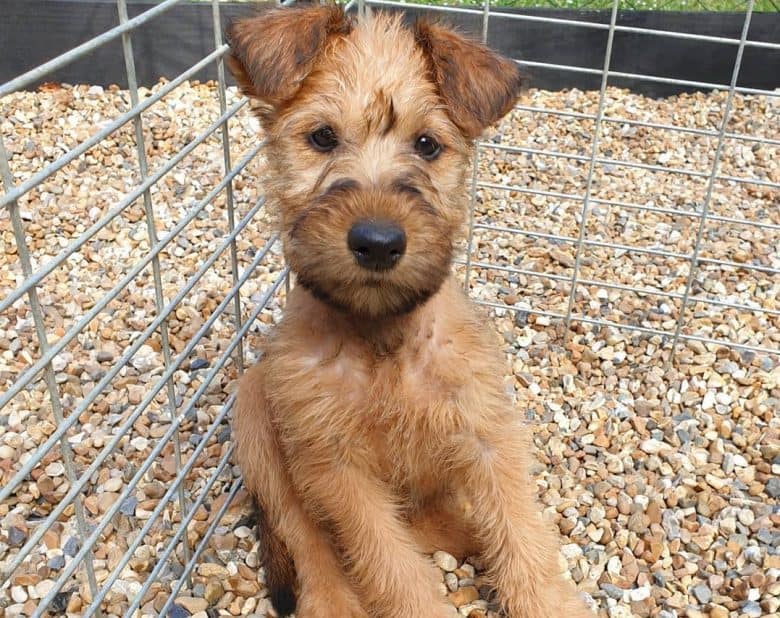
As a purebred, Emerald Eye’s Daredevil will put a bit of a dent in your wallet. Irish Terrier puppies cost anywhere between $600-$1100 USD.
Before buying a puppy of any kind, it’s important to consider some basic questions regarding dog-rearing.
If you do buy an Irish Terrier, it’s not just the initial cost of taking your puppy home but also the costs of raising your dog as well.
Irish Terrier breeders
If you do decide you’re ready to commit, you can find Irish Terrier puppies for sale at pet stores and puppy farms. As purebred, they may be challenging to find.
You may be better off searching on the AKC marketplace for registered Irish Terrier breeders instead.
AKC is the best option when it comes to finding a healthy breed in the United States. This organization only works with reputable breeders who keep dogs in good condition.
When meeting your breeder, the important thing is to ask a ton of questions.
This is the best way to gauge how responsible and clued up your breeder is. You’ll want it to be someone who cares about the dog and is very informed.
Since Irish Terriers often have hereditary health concerns, you should ask the breeder about breed certification.
Any purebred’s certificate will list the dog’s pre-existing conditions to help you stay on top of their health and maintenance.
Irish Terrier for adoption
You can also contact a breeder via breed clubs. Check out the Irish Terrier Club of America’s referral program.
ITCA representatives will gladly put you in touch with someone who has either a puppy for sale or a full-grown Irish Terrier in need of adoption.
The ITCA also raises money for in-need Irish Terriers through their Rescue Program. You can temporarily foster an Irish Terrier or take one home as a new part of your family.
The average litter size of an Irish Terrier is 4-6 puppies.
Curious about Irish Terrier Mixes?
Certain breeds are crossed with the Irish Terrier breed, and we’ve covered three of them below. These are mixes with the Australian Shepherd, the Poodle, and Saint Bernard.
Below is a brief outline of some of the characteristics of these mixed breeds.
Irish Terrier and Australian Shepherd mix
This Irish Aussie Terrier mix combines the Irish Terrier’s drive for hunting with the Australian Shepherd’s aptitude for herding.
This mix gets the more fluffy, cuddly aspect of the Australian Shepherd but remains a medium-sized breed that will do alright living in an apartment.
Irish Terrier and Poodle mix
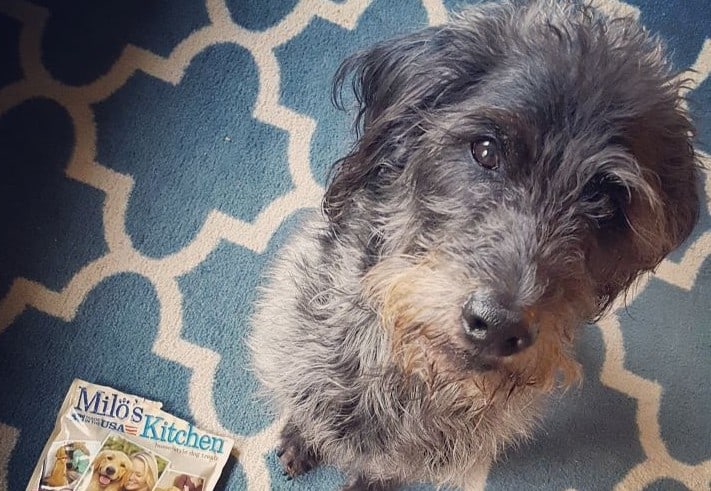
The Irish Terrier/ Poodle mix – or the Irish Troodle – is a smart, energetic, and playful mixed breed. Troodles can be medium to large-sized dogs and are very obedient. Irish Troodles make for great watchdogs.
Irish Terrier and Saint Bernard mix
The Irish Saint Terrier makes for a good watchdog, combining the protective nature of the Irish Terrier with the burliness of the Saint Bernard. These dogs stand taller than the Irish Terrier at about 22 inches (56 cm).
Who should get an Irish Terrier?

Irish Terriers are great first dogs, as they are good listeners with high trainability. This is a good starting option for someone who hasn’t trained a puppy before and is looking for an obedient option.
However, if you work a lot, you’ll need to organize (and be able to afford) a dogsitter, as Irish Terriers do require a considerable amount of attention.
Irish Terriers are ideals as family dogs, especially if you want a dog that will be protective and ward off intruders.
The weather-resilience and low maintenance is also a pro when it comes to ownership, as you won’t need to invest too much time into caring for your Irish Terrier.
These dogs are also great fun to be around, and many prefer them over Welsh Terriers.
If you know something about Irish Terriers that we’ve missed, feel free to comment on this post below and let us know.
Further reading: Terrier Breeds
Cess is the Head of Content Writing at K9 Web and a passionate dog care expert with over 5 years of experience in the Pet Industry. With a background in animal science, dog training, and behavior consulting, her hands-on experience and extensive knowledge make her a trusted source for dog owners.
When not writing or leading the K9 Web content team, Cess can be found volunteering at local shelters and participating in dog-related events.
